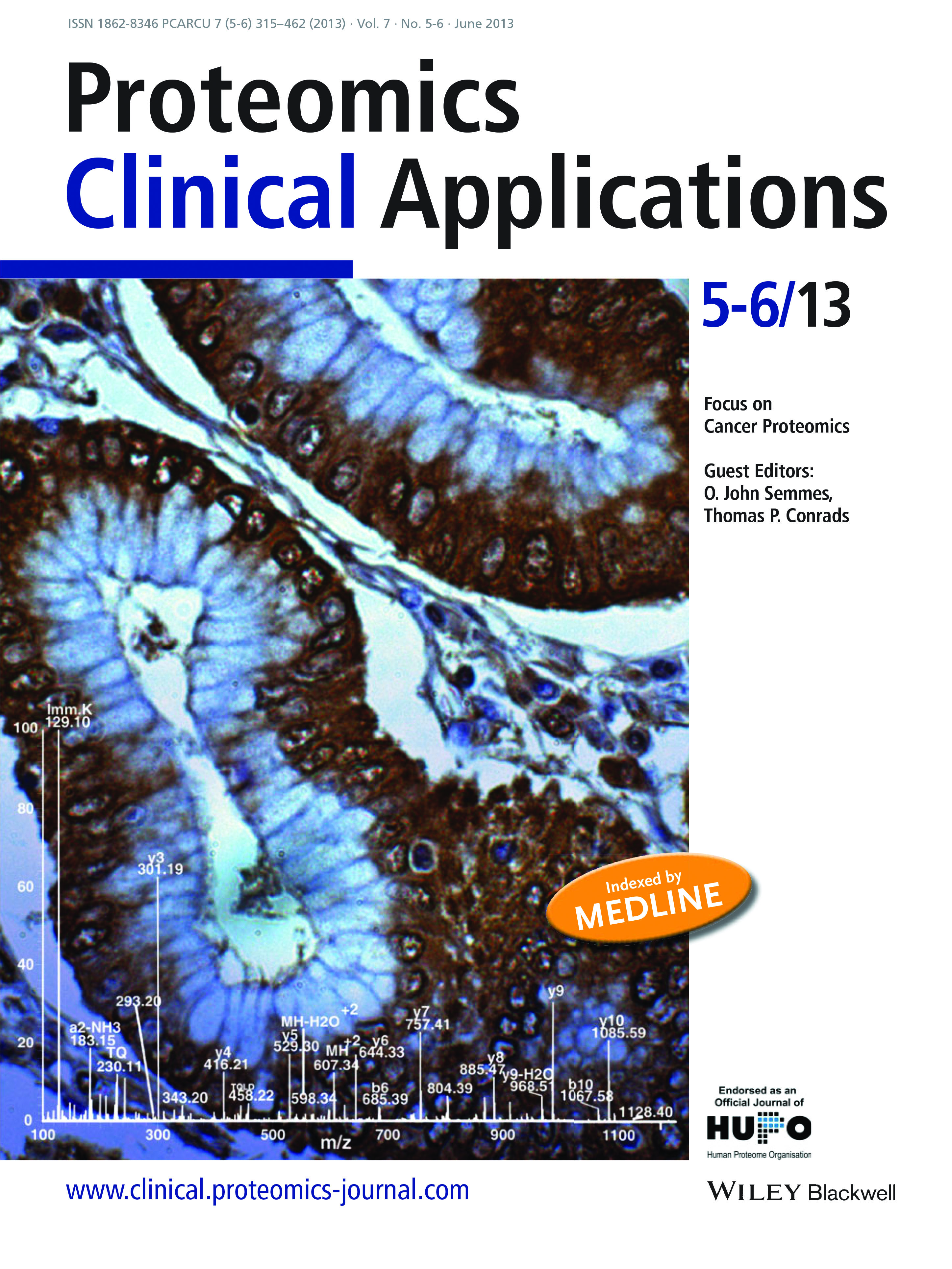Prognostic utility of autoantibodies to α-enolase and Hsp70 for cancer of the gingivo-buccal complex using immunoproteomics
Abstract
Purpose
Studies from our laboratory have reported 14 tumor antigens that elicit an autoantibody response in patients with cancer of the gingivobuccal complex (GBC) In this study, utility of the autoantibody response has been evaluated for prognosis of cancer of the GBC.
Experimental design
Autoantibody response was evaluated using immunoproteomics and the prognostic significance was assessed by Kaplan-Meier survival and multivariate analysis.
Results
Autoantibody response against α-enolase isoforms a, b, and c and Hsp70 was detected in 27, 53, 64, and 26% of the 78 patients, respectively. Patients positive for autoantibody response to α-ENO and Hsp70 individually and in combination, showed significantly reduced disease-free survival (DFS) compared to those who do not show autoantibody response to either of them. Further the patients, who exhibit autoantibody response to α-ENO and Hsp70 in combination with nodal involvement and/or differentiation status, have significantly lowered DFS. The relative risk of recurrence is 3.41 for patients who exhibit autoantibody response to both the antigens.
Conclusions and clinical relevance
Autoantibody response against α-ENO and Hsp70 provides an additional parameter and may be utilized along with nodal involvement and differentiation status for better prognosis of cancer of GBC.
Abbreviations
-
- DFS
-
- disease-free survival
-
- α-ENO
-
- α-enolase isoforms a, b, c together
-
- GBC
-
- Gingivobuccal complex
-
- MD
-
- moderately differentiated
-
- PD
-
- poorly differentiated
-
- TPI
-
- triose phosphate isomerase
-
- WD
-
- well differentiated
1 Introduction
Oral cancer is a major cause of cancer morbidity and mortality in males in India 1. Squamous cell carcinoma of the oral cavity ranks as the 15th most common cancer in the world and 10th most frequent in males 1. In India, the gingivo-buccal complex of the oral cavity is the common site of cancer in males due to the prevalent habit of chewing tobacco 2. A major hurdle in the management of oral cancer is high rate of locoregional recurrence. Currently, diagnosis, treatment, and prognosis of the disease are entirely based on clinical and radiologic and standard histopathologic findings. Such techniques do not allow for recognition of genotypically different tumors with identical morphology and different prognosis. Therefore identification of biological markers is necessary to complement clinicopathological findings for a more accurate prediction of individual patient's prognosis and to help clinicians in planning more effective therapeutic strategies.
A large number of biomarkers are being reported for cancer of the head and neck region 3, 4 and their diagnostic and prognostic utility are being assessed 5-9. Autoantibody response is also receiving increasing attention as a molecular sieve for identifying specific biomarkers for cancer for detection, prognosis, progression, and response to therapy 10-20. It is apparent that autoantibodies to tumor antigens have potential for clinical evaluation, as their levels can be determined in blood using less invasive techniques without the need for biopsies.
Various approaches have been used for identification of autoantibody response in head and neck cancer. These include, ELISA 14, 21-24, immunoproteomics 16, 20, 25, phage display library 15, and AMIDA-autoantibody-mediated identification of antigens 26. In most studies, except ours 16, 20 wherein biomarkers are being identified, attention has not been given to subsite specificity of the oral cavity/head and neck region.
Using immunoproteomics, many tumor antigens and their cognate antibodies have been identified and reported as biomarkers in different cancers 27-31. We have also reported a set of proteins that elicit autoantibody response in patients with cancer of gingivo-buccal complex (GBC), a subsite of the oral cavity 16. Their site specificity is evident, as there is negligible autoantibody response to these antigens in patients with cancer of tongue 20. The tumor antigens reported in our study 16, 20 include α-enolase and Hsp70. Autoantibodies to α-enolase and Hsp70 have been reported in several cancers including those in the head and neck region 16, 21, 32-35. These studies have focused on the diagnostic utility of these tumor markers. In the present study, the utility of these autoantibodies in prognosis of cancer of GBC has been investigated.
2 Materials and methods
2.1 Blood samples from patients with cancer of GBC
This study was approved by the Hospital ethics committee of the Tata Memorial Centre, Mumbai, India. Blood was collected from 78 patients with cancer of GBC with due written consent and serum was isolated as reported earlier 16. Clinical information of the patients was obtained from hospital records and is summarized in Supporting Information Table S1.
2.2 Autoantibody response
Autoantibody response to the tumor antigens identified in our earlier study 16, namely α-enolase (isoforms a, b, and c), peroxiredoxin VI, annexin II, Hsp70, pyruvate kinase, alpha tubulin, beta tubulin, ATP synthase, phosphoglycerate mutase, aldose reductase, and triose phosphate isomerase (TPI) were evaluated in sera of 47 patients with cancer of GBC and 50 healthy individuals using immunoproteomics. Autoantibody response to the same antigens in 31 patients reported in our earlier investigations 16, 20 were also included in this study. Briefly, IgGs were isolated from serum using the Melon gel IgG spin purification kit (Pierce, USA, Cat. No. 45206) as discussed earlier 16. Proteins from KB cell line were resolved by 2DE and blotted on to PVDF membranes and probed with IgGs purified from patients and healthy individuals. The IgGs bound to the antigens were detected with horseradish peroxidase-labeled antihuman IgG and the Enhanced Chemiluminescence (ECL) Detection system (RPN-2132, GE Healthcare, USA) and the image was captured on an x-ray film. Multiple gels and their corresponding blots were processed simultaneously to minimize experimental differences. The presence of a spot was scored as positive when the signal on the autograph was clearly defined by its shape that overlapped with the colloidal gold/amido black pattern for the protein on the PVDF membrane. Details of the 2DE, immunoblotting, and scoring procedures are given in the Supporting Information MMS1.
2.3 Statistical analysis
Statistical analysis was performed using the SPSS 16.0 software package. Clinicopathological parameters were correlated with autoantibody response detected in sera against each tumor antigen using Chi square test. The association of followup information with autoantibody response observed in the patients was evaluated by Kaplan-Meier analysis and multivariate analysis by Cox-regression method.
3 Results
3.1 Assessment of autoantibody response against the tumor antigens by immunoproteomics
The autoantibody response against the antigens identified in our earlier study 16, namely α-enolase (isoforms a, b, and c), peroxiredoxin VI, annexin II, Hsp70, pyruvate kinase, alpha tubulin, beta tubulin, ATP synthase, phosphoglycerate mutase, aldose reductase, and TPI was evaluated in 78 patients with cancer of GBC using the 2DE immunoproteomics approach. Of these, the autoantibody response to 31 patients has been reported in our earlier publications 16, 20. Autoantibody response was also evaluated in 50 healthy individuals as control, Supporting Information Table S2. Representative autographs of KB 2DE immunoblots with signals obtained when probed with purified IgG from patients with cancer of GBC and for the control sera are given in Supporting Information Fig. S1 (A–L).
Supporting Information Table S3 shows the final percentage of autoantibody response to each of the tumor antigens in patients and healthy individuals. Autoantibody response to the antigens varied between 8% for TPI to 64% for α-enolase c and the combination of antigens eliciting an autoantibody response was different among patients. Details of autoantibody response to the antigens by each of the patients considered in this study are given in Supporting Information Table S1. The intensity of the signal for each protein spot was distinct for each patient that reflects the specific autoantibody response of the individual to each antigen. Autoantibody response against α-enolase isoforms a, b, and c was detected in 27, 53, and 64% of the 78 patients, respectively. The autoantibody response to Hsp70 was seen in 26% of the patients. Autoantibody response to three isoforms of α-enolase and Hsp70 was much lower and was seen in 6, 10, 20, and 4%, respectively of normal healthy individuals.
3.2 Correlation of the autoantibody profile for each of the tumor antigens with clinicopathological parameters
Clinical significance of the autoantibody response to tumor antigens and clinicopathologic parameters were assessed using Chi-square test. Significant correlations were seen with Hsp70 and α-ENO. Supporting Information Table S4 shows the data for these two antigens and those for the other antigens is given in the Supporting Information Table S5. Autoantibody response to Hsp70 shows significant correlation with stage, tumor size, nodal status, and recurrence while autoantibody to α-ENO correlates only with differentiation at p = 0.055. The autoantibody response for both the antigens did not correlate with age and sex of the patients.
3.3 Association of autoantibody response with disease-free survival (DFS)
Kaplan-Meier survival analysis was performed for autoantibody response against each tumor antigen reported earlier to assess their independent association with DFS. Fig. 1 (A–D) and Fig. 2 (A–C) show the data for each of the isoforms of α-enolase and all isoforms taken together (α-ENO) and Hsp70. The data for the other antigens is given in the Supporting Information Fig. S2 (A–J). Significant association of autoantibody response with DFS was seen with α-enolase and Hsp70 and this is described in detail below. For the other antigens, the association was not significant, except for TPI for which only 6 of 78 patients showed autoantibody positivity, Supporting Information Fig. S2-J.


3.3.1 Association of autoantibody response to α-ENO isoforms and Hsp70 individually with DFS
Correlation of autoantibody response to each of the three isoforms of α-enolase individually, with DFS of the patients is shown in Fig. 1(A–C). Among the three isoforms, autoantibody response to the isoform α-enolase-c showed significant correlation with DFS of patients (p = 0.0187), Fig. 1C. A similar trend was seen with autoantibody response to α-ENO at p = 0.053, Fig. 1D and for Hsp70 at p = 0.0002, Fig. 2A. It is seen that patients who exhibit autoantibody response to each of the antigens recur significantly faster than those who are negative for autoantibody response.
3.3.2 Association of autoantibody response to Hsp70 and α-ENO in combination with DFS
Patients were grouped in those, who do not show antibody response to either of the antigens, those who exhibit autoantibody response to either Hsp70 or α-ENO, those who show antibody response to both Hsp70 and α-ENO. Autoantibody response seen in these groups was correlated with DFS of patients. The survival curves are shown in Fig. 2B. It is seen that patients with autoantibody response to both antigens recur faster than those without an autoantibody response, p = 0.0013. Similarly presence of autoantibody response to Hsp70 and α-enolase isoform c in combination significantly correlates with DFS of patients (p = 0.0017), Fig. 2C.
From the above, it is clear that presence of an autoantibody response to the two antigens has correlation with DFS and this can be an added parameter for prognosis of cancer of the GBC.
3.4 Nodal and differentiation status of the tumor and DFS
The nodal and differentiation status of the tumor are well-established prognostic clinical parameters. Supporting Information Fig. S3 (A and B) show the survival curves for the patients in this study with respect to these parameters.
3.4.1 Autoantibody response to α-ENO, nodal status, and DFS
The autoantibody response to Hsp70 and α-ENO independently correlate with DFS. The association of each of these parameters in combination with nodal status was evaluated with DFS.
Data from 76 patients (for two patients pathological information was not available to assess nodal status) were divided into four groups based on the presence of antibody response to α-ENO and nodal involvement. The survival curve obtained for each group is shown in Fig. 3A. The overall trend is statistically significant at p = 0.0002. Importantly, there is a clear decrease in DFS in patients who have node negative tumors and exhibit an autoantibody response to α-ENO and those who do not. Similarly among node positive patients, individuals who exhibit autoantibody to α-ENO recur faster. A similar significant trend was observed when autoantibody response to only α-enolase c isoform was correlated with DFS of patients along with the nodal involvement (p = 0.0003), Fig. 3B.

3.4.2 Autoantibody response to Hsp70, nodal status, and DFS
Data from 76 patients were divided into four groups based on the presence of antibody response to Hsp70 and nodal involvement. The survival curve obtained for each group is shown in Fig. 3C. The overall trend is significant at p = 0.0001. It is noted that there is a significant decrease in DFS (p = 0.049) in patients positive for autoantibody response to Hsp70 and nodal involvement as compared to patients positive only for node. In addition, there is also a significant difference in DFS of patients (p = 0.050) between the group negative for both node and antibody response to Hsp70 and the group positive for antibody response to Hsp70 but negative for node.
3.4.3 Autoantibody response to both α-ENO and Hsp70, nodal status, and DFS
Presence of autoantibody response to either Hsp70 or α-ENO or both in sera correlates independently to the DFS of patients. To determine their potential as an additional prognostic marker in combination, survival analysis was performed with nodal involvement. Data from 76 patients were divided into six groups based on the presence of antibody response to either α-ENO or Hsp70 or both and nodal status. Fig. 3D shows the survival curves obtained for each group. It is seen that patients who are negative for both autoantibody response to Hsp70 and α-ENO and node fare better than those who are positive for antibody response to either Hsp70 or α-ENO or both and negative for node. Similarly, the patients negative for antibody response to both Hsp70 and α-ENO and positive for node fare better than patients positive for antibody response to either Hsp70 or α-ENO or both as well as node.
In summary, autoantibody response to both antigens is an added parameter to node positivity for prognosis of cancer of GBC.
3.4.4 Autoantibody response to α-ENO and Hsp70 individually, differentiation status, and DFS
The parameters, differentiation, and autoantibody response to α-ENO alone or Hsp70 alone independently correlated with DFS as shown above. To determine whether the two parameters have any additive effect on DFS of the patients, data from 77 patients (for one patient differentiation status was not available) were divided into six groups based on the presence of autoantibody response to α-ENO and differentiation status of the tumors. The survival curves obtained are shown in Fig. 4A. The group with well differentiated (WD) or moderately differentiated (WD/MD) tumors and positive for antibody response to α-ENO has reduced DFS relative to the group with WD/MD tumors and negative for antibody response to α-ENO.

The group with poorly differentiated (PD) tumors and positive for antibody response to α-ENO has significantly reduced DFS from group with PD tumor and negative for autoantibody to α-ENO. The overall trend is significant at p = 0.012. Similarly, presence of antibody response to Hsp70 showed significant correlation with DFS along with the differentiation status of tumor (p = 0.0002), Fig. 4B.
3.4.5 Autoantibody response to α-ENO and Hsp70, differentiation status, and DFS
The data from 77 patients were divided into six groups based on autoantibody positivity and differentiation status. The survival curves in Fig. 4C show that those patients with PD tumors who exhibit autoantibody to α-ENO and Hsp70 recur faster than those who are negative for an autoantibody response to both or either antigens. Similarly, patients with MD/WD tumors who exhibit antibody response to both antigens recur faster than those who are negative for autoantibody response. The overall trend is significant at p = 0.001.
The emerging data shows that autoantibody response to α-ENO and Hsp70 alone and in combination is an added parameter, which with differentiation status of the tumor can improve the prognosis of cancer of GBC.
3.5 Multivariate analysis
Cox regression analysis was performed to determine the prognostic potential of autoantibody response to α-ENO and Hsp70 for cancer of GBC in combination with the clinical parameters, differentiation, and nodal status. Table 1 shows that the relative risk of recurrence is 3.41 when the patients exhibit autoantibody response to both the antigens supporting their potential as added parameters that influence the prognosis of the disease.
| Number of | Relative | 95% CI for relative risk | Significance | |||
|---|---|---|---|---|---|---|
| patients | risk | (p) | ||||
| Lower | Upper | |||||
| Differentiation status | WD/MD | 51 | 2.29 | 1.14 | 4.6 | 0.020 |
| PD | 24 | |||||
| Nodal involvement | −ve | 41 | 2.98 | 1.49 | 5.96 | 0.002 |
| +ve | 34 | |||||
| Autoantibody response to | (−ve/−ve) | 23 | 1.6 | 0.63 | 4.1 | 0.318 |
| Hsp70 and α-Enolase | (−ve/+ve) | 35 | ||||
| (+ve/+ve) | 17 | 3.41 | 1.28 | 9.0 | 0.014 | |
- WD, well differentiated; MD, moderately differentiated; PD, poorly differentiated; CI: confidence interval.
4 Discussion
Autoantibody response against tumor antigens has been receiving attention for its utility in early detection and prognosis of cancer. There are several studies evaluating autoantibody response vis a vis disease progression or prognosis. Mudenda et al. have shown that the presence of autoantibodies to p53 correlate positively with high histological grade of breast cancer 10. Chang et al. studied autoantibody response against survivin in 134 patients with head and neck cancer and found survivin antibodies in 33% patients with stage I and II while 51% patients with stage III and IV showed survivin antibodies. Autoantibodies to survivin were seen in 38, 46, and 65% of the patients with well, moderately, and poorly differentiated tumor, respectively 14. Mitsudomi et al. found that high incidence of p53 autoantibodies is associated with high histological grade of nonsmall cell lung cancer but not with patient survival. They observed p53 autoantibodies in 14% of early stage group (Stage I and II) and 30% of advanced disease group (Stage III and IV) 13.
In the present study, we have examined the prognostic utility of presence of autoantibody response to the tumor antigens reported earlier from our laboratory 16 in sera of patients with cancer of GBC using immunoproteomics. Patients positive for autoantibody response to α-ENO or Hsp70 showed faster recurrence compared to those who do not show autoantibody response to either of them. Further, we show that autoantibody response to α-ENO and Hsp70 is an additional parameter that in combination with nodal involvement and/or differentiation status of tumor improves the prognosis of cancer of the GBC. This information could possibly be used by the clinician to modify treatment strategies according to the aggressiveness of the tumor.
α-Enolase is reported to be multifunctional 36. It can exist both in cytoplasm as well on the cell surface. A truncated version of α-ENO MBP-1 is also expressed, which is localized in the nucleus and acts as a transcription repressor by binding to c-Myc promoter. Cell surface α-ENO apart from its catalytic activity may also act as a plaminogen receptor. Binding of plasminogen to α-enolase leads to its activation to plasmin by proteolytic cleavage. In breast, lung, and pancreatic neoplasia, α-enolase is localized on the surface of cancer cells where it may act as a plasminogen receptor 35, 37, 38. The exact mechanism involved in the production of autoantibodies to α-enolase in oral cancer is presently unclear. We have earlier reported that expression of α-enolase is increased in cancer of GBC 39 that may be a reason for the generation of autoantibody response. Tsai et al. 9 have shown ENO1 overexpression as a prognostic marker in head and neck cancer.
Autoantibody responses to α-enolase have been reported in cancers of the pancreas 37, leukemia 32, melanoma 40, head and neck/oral cavity 16, 20, breast 41, and lung 35, 42. In a recent study, Tomaino et al. have reported that in pancreatic cancer patients, autoantibodies to ENOA are directed against two upregulated isoforms phosphorylated on Ser 419 43.
Hsp70 is another multifunctional protein that plays a role in regulating protein quality and turnover in normal conditions as well under stress. Autoantibodies to Hsp70 have been reported in cancer of the esophagus 25, lung 34, liver 33, oral cavity, and head and neck 21 and leukemia 32. Hsp70 is reported to be overexpressed in the cancer of head and neck and oral cavity 44. There are divergent reports of its prognostic relevance in oral cancer 45. Autoantibody response to Hsp70 detected in sera of patients with cancer of GBC correlated significantly both with the size and stage of tumor and was more in patients with advanced stage of tumor. Further, there is a decrease in DFS with increase in autoantibody response.
Clinical Relevance
Squamous cell carcinoma of the oral cavity ranks as the 15th most common cancer in the world and 10th most frequent in males. In India, the gingivo-buccal complex (GBC) a subsite of the oral cavity, is the common site of cancer in males due to the prevalent habit of chewing tobacco. A major hurdle in the management of oral cancer is high rate of locoregional recurrence. Biological markers are necessary to complement clinicopathological findings for better prognosis.
Using immunoproteomics, we have reported earlier a set of tumor antigens that elicit autoantibody response in patients with cancer of GBC. The reported antigens include α-enolase isoforms a, b and c and Hsp70. Autoantibodies to α-enolase and Hsp70 have been reported in several cancers, wherein they have focused on the diagnostic utility of these biomarkers. In the present study, the utility of the autoantibody response to the antigens in prognosis of cancer of GBC has been investigated.
Our data show that autoantibody response against α-ENO and Hsp70 provides an additional parameter for predicting disease-free survival and recurrence and may be utilized along with nodal involvement and differentiation status for better prognosis of cancer of GBC.
Autoantibodies have been either reported to improve the prognosis of cancer patients, to worsen the clinical outcome, or even to be irrelevant for the course of the disease. For example autoantibodies to p53 have shown variable correlations with disease outcome in different cancers. Lubin et al. and Tang et al. have shown autoantibody response to be associated with high-grade tumors and poor survival in breast, colon, oral, and gastric cancers 48, 49 while in another study, Saffroy et al. have shown correlation of autoantibody response with enhanced overall survival in HCC patients 50. It was anticipated that as the disease progressed the host immune surveillance mechanisms would elicit an antibody response as a measure to counter the progressing cancer and there should have been a direct reflection of this with an increase in the DFS status. It is apparent that the scenario is more complex and as described by Tan and Coussens in their review 51 enhanced humoral immunity and inflammation in combination with suppressed cell-mediated immunity are responsible for the pathogenenesis of several human cancers. Further studies are therefore required to understand the observations in this study.
In summary, autoantibody response against α-ENO and Hsp70 provides an additional parameter for predicting DFS and recurrence and may be utilized along with nodal involvement and differentiation status for better prognosis of cancer of GBC.
Acknowledgments
The work was supported by a grant from Council of Scientific and Industrial Research, (27(0151)/06/EMR-II) and institutional funds from ACTREC to Dr. Surekha Zingde. Sanjeev Shukla was supported by a fellowship from ACTREC during 2003 to 2007 and Lady Tata Memorial Trust, (LTMT) during 2007–2008, India. Atul Pranay was supported by a fellowship from ACTREC, India.
All authors have declared no conflicts of interest.




